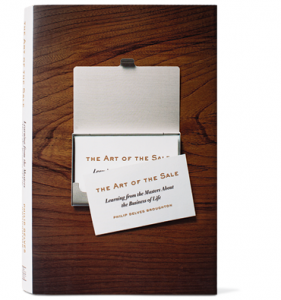The Art of the Sale
 When I first learned about The Art of the Sale last Friday, I knew I had to read it. I downloaded it immediately to my Kindle and finished it on Saturday morning somewhere between California and Florida. It’s that good.
When I first learned about The Art of the Sale last Friday, I knew I had to read it. I downloaded it immediately to my Kindle and finished it on Saturday morning somewhere between California and Florida. It’s that good.
There are three key messages in this book:
The overlooked importance of selling in business and life
The book is useful for sales professionals and non-salespeople alike. I wish everyone in business who is not in sales would read this book, because it explains why nothing in business would happen without the special talents, tenacity and hard work of salespeople. Business is fundamentally about two things: a) producing goods and services and b) selling them. Guess which one of those two is almost never taught in the typical MBA program? “All over the world, from the most basic to the most advanced economies, selling is the horse that pulls the cart of business.”
In spite of this, “Many supposedly well-educated people in the business world are clueless about one of its most vital functions, the means by which you actually generate revenue. The absence of knowledge about sales has opened a class division between salespeople and the rest of business.” If you want to contribute to closing this class division, give copies of this book to your leadership team.
And it’s not just business; in life, you are always selling or being sold to. Unless you’re a hermit, most of what you do in life has to be done through others, and selling is the vehicle of interpersonal relationships.
Examining the dilemmas and tradeoffs of selling
Broughton also helps to put into perspective and clear up some misconceptions about the motivation and integrity of those who sell for a living. Of course there are dishonest and pushy salespeople, and there are those who see customers only as instruments of their own commissions. The same could be said for any other profession. Broughton examines the balance and sometime contradiction between trying to sell a product and being paid to sell it.
Selling is neutral; intention makes the difference. When you sincerely believe that what you are selling will improve the life of the buyer in some way, there is nothing wrong with trying hard to sell them on it. In the end, it’s much easier to be really good at something when it aligns with your values and your sense of meaning, and as Broughton tells us, “…the best salespeople see themselves as the means by which customers achieve their purpose.”
Portraying the qualities of great salespeople
If you’ve been in sales for any length of time you won’t learn anything new in this book, but you will be inspired and recharged by the stories of some remarkable individuals who portray the great virtues that all of us could use more of: optimism, resilience, lifelong learning, and work ethic. When you read about the pace kept by Memo, the Mexican immigrant who has created a successful construction business, you realize that you don’t work near as hard as you could. Majid in Tangier reminds you about submerging your ego, keeping quiet and learning. Although I’m not sure what its lesson is, the story of Ted Turner’s pitch to the New York advertising agency is worth the price of the book. It’s not a story I can repeat on a PG-rated blog, so you’ll have to buy the book.
The common thread in most of these stories is that selling is the “great leveler”; when you can sell, when you can apply these virtues in sufficient quantities, you can make what you want out of your life.
Ditch the Pseudo-Science
The book does contain one annoying flaw. The science parts feel as if they have been bolted on to please a marketing manager; whenever it seeks to inject science into the discussion, it’s forced, superficial and inaccurate. For example, he tries to explain one salesperson’s success using a technical explanation involving fluid intelligence and working memory that mostly points out ignorance of what those terms really mean. In another chapter, he throws in a few pages about the evolution of cooperation and altruism, and tries to connect it to the use of Salesforce.com. (May I just don’t have the fluid intelligence to understand the connection.)
Despite that last complaint, I strongly recommend this book. If you’re in sales, you will want to read it; if you’re not, you need to read it.




[…] The Art of the Sale […]